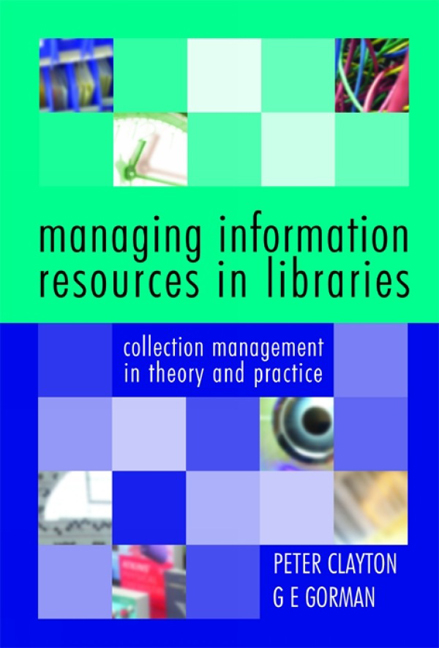Book contents
- Frontmatter
- Contents
- About the authors
- Preface
- 1 Managing information resources in context
- 2 Collection management and collection development policies
- 3 Conspectus
- 4 Resource sharing and co-operative collection development
- 5 Selection: policies and procedures
- 6 Selection resources
- 7 Acquisitions processes and procedures
- 8 Budget management
- 9 Collection evaluation and review
- 10 Preservation and weeding
- The literature of collection management Adela Clayton
- Index
4 - Resource sharing and co-operative collection development
Published online by Cambridge University Press: 08 June 2018
- Frontmatter
- Contents
- About the authors
- Preface
- 1 Managing information resources in context
- 2 Collection management and collection development policies
- 3 Conspectus
- 4 Resource sharing and co-operative collection development
- 5 Selection: policies and procedures
- 6 Selection resources
- 7 Acquisitions processes and procedures
- 8 Budget management
- 9 Collection evaluation and review
- 10 Preservation and weeding
- The literature of collection management Adela Clayton
- Index
Summary
Focus questions
• What is the purpose of co-operation, and what are the benefits?
• What are the barriers to co-operation, and how might they be overcome?
• What are the principal characteristics of effective resource-sharing management?
Resource sharing and co-operation, especially co-operative collection development, are essential components in collection management – and this has been the case rather longer than these have been ‘hot topics’ among information professionals. In the USA, for example, it has long been a part of professional practice, as the Association of Specialized and Cooperative Library Agencies recognizes:
Cooperation among libraries is not a new phenomenon and, indeed, over a century of cooperation among librarians in the United States makes up the heritage of present day practitioners. That libraries should be able to work co-operatively to find access to information in distant collections which is not available locally is a deeply rooted concept in librarianship.
Co-operation occurs at many levels and in most areas of library service, from joint storage facilities and shared technical processing services to interlibrary loans (ILL) and reciprocal access for users. But this chapter is about co-operation at the level of collection development, with the intention of providing readers with access to a wider range of information resources.
Co-operative activities are becoming increasingly important for service delivery, primarily because of the ever-expanding availability of electronic data and improvements in telecommunications. Network access to online catalogues facilitates resource sharing at the item level – the only level of real interest to most clients. But having established that another library has what is wanted, how is it to be obtained? Network access to the electronic documents themselves poses a different set of problems. Some of these – including costs, access and preservation – were noted in Chapter 1. Book loans remain at the pace of ‘snail mail’ but journal articles, at least, can routinely be faxed to the requester. And there is good evidence that electronic service delivery results in greater usage of resources.
- Type
- Chapter
- Information
- Managing Information Resources in LibrariesCollection Management in Theory and Practice, pp. 52 - 72Publisher: FacetPrint publication year: 2006



